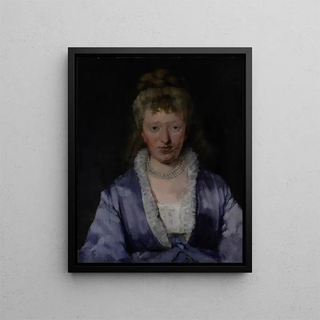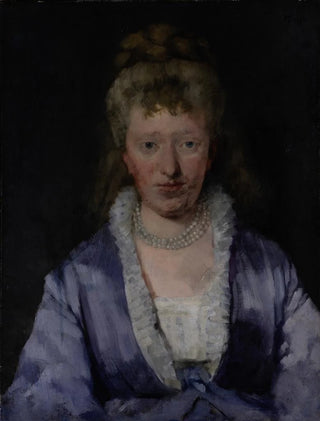Taidetuloste | Portrait of a lady in a violet dress - Wilhelm Trübner


Takaa näkyvä näkymä

Kehys (valinnainen)
Reproduction Portrait of a Lady in a Violet Dress - Wilhelm Trübner – Engaging Introduction
The "Portrait of a Lady in a Violet Dress" by Wilhelm Trübner is a work that transcends the simple portrait frame to capture the very essence of femininity at the turn of the 20th century. This painting, rich in nuances and emotions, invites the viewer to immerse themselves in a universe where beauty and sophistication meet. The delicacy of the lady's features, combined with the depth of colors, creates a visual dialogue that fascinates and intrigues. Through this masterpiece, Trübner offers us a suspended moment, a window into an era where art reflected the aspirations and dreams of a generation.
Style and uniqueness of the work
The uniqueness of this work lies in Wilhelm Trübner's mastery of colors and textures, which he deploys with brilliance. The violet dress, a true centerpiece of the painting, seems to vibrate under the light, while delicate shadows accentuate the lady's silhouette. The palette chosen by the artist, oscillating between rich tones and subtle nuances, creates an atmosphere that is both intimate and mysterious. The details, whether it be the folds of the dress or the sparkle of jewelry, testify to a meticulous attention that reveals Trübner's exceptional talent. Furthermore, the penetrating gaze of the lady, charged with palpable emotion, establishes a direct connection with the viewer, inviting them to question her story and thoughts. This portrait is not merely a representation but an invitation to explore the depths of the human soul.
The artist and his influence
Wilhelm Trübner, an emblematic figure of the German artistic movement, managed to mark his era with a style that combines realism and impressionism. Born in 1851, he was influenced by the artistic currents of his time while developing a personal approach that is uniquely his own. Trübner captured the beauty of women of his era, making them timeless muses. His work has been praised for its ability to blend technique and emotion, creating works that still resonate today. As a teacher and mentor, he also played a crucial role in the training of young

Rendu mat

Takaa näkyvä näkymä

Kehys (valinnainen)
Reproduction Portrait of a Lady in a Violet Dress - Wilhelm Trübner – Engaging Introduction
The "Portrait of a Lady in a Violet Dress" by Wilhelm Trübner is a work that transcends the simple portrait frame to capture the very essence of femininity at the turn of the 20th century. This painting, rich in nuances and emotions, invites the viewer to immerse themselves in a universe where beauty and sophistication meet. The delicacy of the lady's features, combined with the depth of colors, creates a visual dialogue that fascinates and intrigues. Through this masterpiece, Trübner offers us a suspended moment, a window into an era where art reflected the aspirations and dreams of a generation.
Style and uniqueness of the work
The uniqueness of this work lies in Wilhelm Trübner's mastery of colors and textures, which he deploys with brilliance. The violet dress, a true centerpiece of the painting, seems to vibrate under the light, while delicate shadows accentuate the lady's silhouette. The palette chosen by the artist, oscillating between rich tones and subtle nuances, creates an atmosphere that is both intimate and mysterious. The details, whether it be the folds of the dress or the sparkle of jewelry, testify to a meticulous attention that reveals Trübner's exceptional talent. Furthermore, the penetrating gaze of the lady, charged with palpable emotion, establishes a direct connection with the viewer, inviting them to question her story and thoughts. This portrait is not merely a representation but an invitation to explore the depths of the human soul.
The artist and his influence
Wilhelm Trübner, an emblematic figure of the German artistic movement, managed to mark his era with a style that combines realism and impressionism. Born in 1851, he was influenced by the artistic currents of his time while developing a personal approach that is uniquely his own. Trübner captured the beauty of women of his era, making them timeless muses. His work has been praised for its ability to blend technique and emotion, creating works that still resonate today. As a teacher and mentor, he also played a crucial role in the training of young






